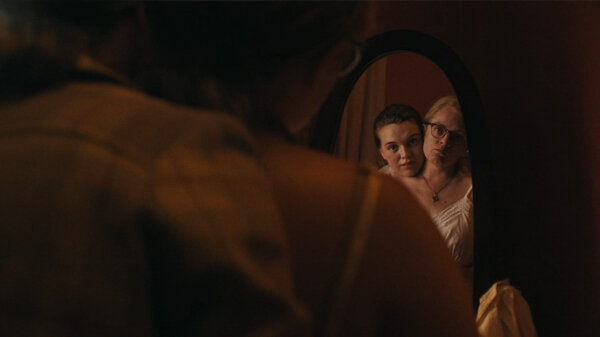Josephine Decker is proving herself once more as one of our most uncompromising and innovative filmmakers working today – but she’s also found the perfect subject matter for it. Her Shirley, an anti-biopic about gothic horror author Shirley Jackson, explores and elevates the way Jackson herself was always refracting several versions of herself. Laura Venning unpacks the complexities of this indomitable woman.
Shirley Jackson once referred to herself as “this compound of creatures I call Me.” Author, wife, mother, witch; she had many faces and struggled to reconcile them behind one unifying mask. Her creativity always had to contend with domesticity, the mental illness she experienced in her late teens continued to rear its head, and though she loved her children she felt trapped by her unfaithful, overbearing husband. She wrote that one of her greatest anxieties was “being someone else and doing the things someone else wants us to do.” That unstable relationship with her own identity, of being controlled and split into pieces by others, is at the heart of almost everything she ever wrote.
Josephine Decker’s Shirley is hardly a straightforward biopic. All biopics streamline the facts, but Shirley is so defiant that it barely warrants the label. This portrait of Jackson is pitch-black and wickedly playful, twisting the truth to spin a yarn that’s darker than reality. Yet that slippage between fact and fiction is ironically far more truthful to Jackson than any pedantic paint-by-numbers rendering.
Fall, 1948. Shirley (Elisabeth Moss) has shocked The New Yorker’s readers with a “thrillingly horrible” short story: The Lottery. Now she announces that she has a title for a new novel, Hangsaman. It is to be based on the disappearance of Paula Jean Welden, a student from the women’s college in Vermont where her husband, Stanley Hyman (Michael Stuhlbarg), lectures on folklore. In a tone dripping with condescension he dismisses her idea as trite; this girl isn’t interesting enough to be a protagonist. Besides, Shirley can’t be capable of writing a novel when she’s too afraid to leave the house. Can’t she get out of bed for once and churn out another Lottery?
Just as one girl disappears, another emerges. Fred Nemser (Logan Lerman) is Stanley’s new teaching assistant and lodger, but it’s his pregnant wife Rose (Odessa Young) who catches Shirley’s attention, and the two women quickly fall into an uneasy infatuation. Decker seems to be leading us down a straight and narrow path through the woods – except the Nemsers never having existed at all is just the beginning of her radical reshaping of the biopic.
Decker’s Shirley is a malevolent spirit haunting a shadowy house shot through a woozy, acid-green haze. She eyeballs everyone scornfully from behind cat-eye glasses, drinks too much and flees into the woods in a nightgown, taunting Rose with a death-cap mushroom. “It could stop our hearts from beating,” she challenges. Time stands still, is Rose horrified or tempted? Shirley bites into it then cackles, it’s not poisonous at all. Rose kneels beside her and opens her mouth in surrender. Shirley feeds it to her; as soon as it touches her lips the spell is cast and the two are entwined. Shirley sees visions of the missing girl, her inspiration for Hangsaman, flitting through the woods. At first the girl is faceless but then it’s Rose’s face disappearing into the trees. The walls between fact and fiction are already crumbling, identities fracturing.
In reality, while Jackson struggled with mental health problems throughout her life, the anxiety, delusions and agoraphobia that kept her housebound didn’t arise until the early 1960s, a decade after Hangsaman was published. According to her biographer Ruth Franklin, there is also no evidence that Hangsaman was inspired by Paula Jean Welden’s disappearance.
The novel is a descent into madness inspired by Jackson’s own breakdown when she was a student, the college where Hyman taught, and her troubled marriage – including one occasion she described in her diary when Hyman raped her. Hangsaman’s Natalie, neglected by her parents, sexually assaulted by a much older man and isolated by her peers, loses her grip on reality during her first year of college. She has a vision of a woman named Tony who tries to seduce her and convinces her to end her own life by jumping from a bridge, alluded to by Shirley’s clifftop climax. At the last moment, Natalie resists, Tony vanishes, and she walks away unharmed. The missing girl finds herself.
Jackson used Natalie as an alter-ego to exorcise some of her own demons. Likewise, Decker’s Rose Nemser never existed, but she’s a reflection of the multiple identities that Shirley Jackson encompassed. Lesbian desire is a consistent undercurrent in her writing, most explicitly in Hangsaman, and it’s present in the erotic charge between Shirley and Rose. But through Rose we also witness Jackson’s doomed efforts to mould herself into the perfect wife and mother. Rose’s husband is unfaithful too, and after she discovers the truth she thrusts her baby into Shirley’s arms and walks to the edge of a precipice, nearly letting herself fall. Jackson never seriously considered suicide, but she contemplated breaking free by leaving Hyman many times.
Shirley’s most drastic diversion from the truth is the omission of Jackson and Hyman’s four children. It’s a practical move, allowing their poisonous marriage to fester. Yet Jackson’s children significantly impacted her career: motherhood forced her to balance her writing against childcare and became a major source of inspiration. 1953’s Life Among the Savages, a collection of light-hearted autobiographical stories chronicling her family’s misadventures, was more successful than most of her fiction.
But the charming stories in Savages don’t represent the “real” Shirley Jackson any more than Decker’s Shirley does. Jackson hid Hyman’s affairs and controlling behaviour, and buried her desperation in her diaries instead. She used Hangsaman to express some of her darkest feelings behind a fictional facade, while in Savages she constructed a sanitised image of herself to sell to housewives. Would she have disapproved of Decker reconstructing the truth for the sake of a better story?
Jackson purists may be horrified. Jackson’s eldest son, Laurence Jackson Hyman, stated that “If someone comes to the movie not knowing anything about my parents, they will certainly leave thinking that my mother was a crazy alcoholic and my father was a mean critic.” But the wild-eyed Shirley who teases Rose with a poisonous mushroom and plants seeds of paranoia in her mind is the same Shirley who tells her softly that “The world is too cruel to girls.” She feels the pull of that cliff edge, watching Rose threaten to jump with both compassion and longing, but one twisted smile from Stanley and she is re-enveloped in their tangled, toxic codependency. Decker’s portrait is steeped in ambiguity, and the key to unlocking it is to see her incarnation of Jackson as a character within one of her own stories.
Like the real Jackson and all her transgressive heroines, from The Haunting of Hill House’s Eleanor to We Have Always Lived in the Castle’s Merricat, this fictionalised Shirley is a caged animal. She tells Stanley that “There are dozens and dozens of lonely girls who cannot make the world see them,” and she longs for an impossible escape from herself – maybe to the point where she’d run towards her own oblivion and become another missing girl.
The Hanged Man tarot card signifies transformation, not death. His face is impassive, even serene, and he hangs by his ankle, not his neck. Shirley conducts a tarot reading for Rose and draws The Hanged Man three times. What kind of transformation occurs? At the end of Hangsaman Natalie walks away from the edge of her own mind transformed, and Decker’s Shirley and Rose do the same. None of them are healed, but one step towards inner reconciliation is possible at last.
Laura Venning (@laura_venning) is a writer and works for a charity based in London. She’s particularly interested in female directors and Australian and New Zealand cinema and has written for Little White Lies, The Digital Fix, Screen Queens and more.



